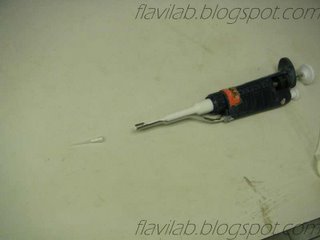
Friday, December 16, 2005
Real?
The one on top, is it real? Got bleached by the washing machine? Don't know. Folded it up and bought chicken rice with it.


Thursday, December 15, 2005
Pokemon causes cancer
Nature 438, 897 (15 December 2005) doi:10.1038/438897a
Pokémon blocks gene name
Tom Simonite
Moniker proves too much for games company.
A cancer research institute has been threatened with legal action by the US branch of Japanese video-game franchise Pokémon, after one of its researchers borrowed the company's trademark to name an oncogene.
Pier Paolo Pandolfi of the Memorial Sloan-Kettering Cancer Center, New York, first called the new member of the POK family of genes Pokemon at a conference in 2001, claiming it was an acronym for POK erythroid myeloid ontogenic. But when Pandolfi and his colleagues described the gene's role in the development of human cancer in Nature last January, the discovery attracted headlines such as 'Pokemon's cancer role revealed' (T. Maeda et al. Nature 433, 278–285; 2005). Message boards and blogs picked up the story, unable to resist using the phrase 'Pokemon causes cancer'.
That led Pokémon USA to exert its legal right to the trademark, Nature has learned. "They threatened to sue us if we did not stop calling the gene Pokemon," says Pandolfi, "but the name and the gene have nothing to do with the cartoon." A spokeswoman for Pokémon USA told Nature that its image was at risk. "We don't want our image undermined by associating Pokémon with cancer," she said.
This is not the first case of trademark law interfering with a researcher's attempt to name a gene. In 1993, Alfonso Martinez Arias of the University of Cambridge, UK, was told to find an alternative name for his new fly gene Velcro, after the Velcro Corporation wrote to the journal that was publishing his paper to say that "such usage invariably dilutes the value of our name and mark".
Perhaps the best-known quirkily titled gene, the fly-development gene Sonic hedgehog, has so far escaped legal threats, despite sharing a name with the spiky electric-blue star owned by that other Japanese video-game giant Sega. Bob Riddle came up with the name in 1993 while working at Harvard University Medical School, but says he doesn't think Sega's image is threatened. "I don't think a development gene harms them," he explains.
Martinez Arias says he has been more careful since his experience with Velcro, but that trademark infringements will continue if geneticists keep looking for catchy names. "They name genes as if they are claiming a new continent," he says. Safe, if boring, systematic names such as those of the Human Genome Nomenclature Committee (HGNC) should be used instead, says Martinez Arias. The Sloan-Kettering centre seems to agree, and is now calling Pandolfi's gene by the HGNC-recognized moniker Zbtb7.
Pokémon blocks gene name
Tom Simonite
Moniker proves too much for games company.
A cancer research institute has been threatened with legal action by the US branch of Japanese video-game franchise Pokémon, after one of its researchers borrowed the company's trademark to name an oncogene.
Pier Paolo Pandolfi of the Memorial Sloan-Kettering Cancer Center, New York, first called the new member of the POK family of genes Pokemon at a conference in 2001, claiming it was an acronym for POK erythroid myeloid ontogenic. But when Pandolfi and his colleagues described the gene's role in the development of human cancer in Nature last January, the discovery attracted headlines such as 'Pokemon's cancer role revealed' (T. Maeda et al. Nature 433, 278–285; 2005). Message boards and blogs picked up the story, unable to resist using the phrase 'Pokemon causes cancer'.
That led Pokémon USA to exert its legal right to the trademark, Nature has learned. "They threatened to sue us if we did not stop calling the gene Pokemon," says Pandolfi, "but the name and the gene have nothing to do with the cartoon." A spokeswoman for Pokémon USA told Nature that its image was at risk. "We don't want our image undermined by associating Pokémon with cancer," she said.
This is not the first case of trademark law interfering with a researcher's attempt to name a gene. In 1993, Alfonso Martinez Arias of the University of Cambridge, UK, was told to find an alternative name for his new fly gene Velcro, after the Velcro Corporation wrote to the journal that was publishing his paper to say that "such usage invariably dilutes the value of our name and mark".
Perhaps the best-known quirkily titled gene, the fly-development gene Sonic hedgehog, has so far escaped legal threats, despite sharing a name with the spiky electric-blue star owned by that other Japanese video-game giant Sega. Bob Riddle came up with the name in 1993 while working at Harvard University Medical School, but says he doesn't think Sega's image is threatened. "I don't think a development gene harms them," he explains.
Martinez Arias says he has been more careful since his experience with Velcro, but that trademark infringements will continue if geneticists keep looking for catchy names. "They name genes as if they are claiming a new continent," he says. Safe, if boring, systematic names such as those of the Human Genome Nomenclature Committee (HGNC) should be used instead, says Martinez Arias. The Sloan-Kettering centre seems to agree, and is now calling Pandolfi's gene by the HGNC-recognized moniker Zbtb7.
Wednesday, December 14, 2005
The Pond part III
Tuesday, December 13, 2005
Teren the terror
Teren the terror broke a pipettor!
Welding his superhuman strength, he trust forth his power onto the tiny pipettor shaft, breaking its neck and leaving it stuck in the pipette tip; mortified, fractured, dead.
*shudder*

This is what a 'normal' pipettor should look like.

This is what Teren did to the one of the P2 we have, rather, had. ouch.

Closeup of the broken shaft. Much like decapitation.

The end of the shaft still stuck in the white tip.

You can see the little hole in the middle of the shaft.
But fear not, fret not, cry not!
Gilson sells replacement parts! Hurrah, a new lease of life will come soon for this unfortunate soul.
http://www.gilson.com/Products/prodInfo.asp?pID=67&ttID=3
If you would like pipettors like P2 to enjoy a new lease of lab life, contribute now to the Help-Get-New-Stuff-For-My-Lab program. Just call 1800-NEW-STUFF or 1800-639-78833 NOW to donate $100.00!
Welding his superhuman strength, he trust forth his power onto the tiny pipettor shaft, breaking its neck and leaving it stuck in the pipette tip; mortified, fractured, dead.
*shudder*

This is what a 'normal' pipettor should look like.

This is what Teren did to the one of the P2 we have, rather, had. ouch.

Closeup of the broken shaft. Much like decapitation.

The end of the shaft still stuck in the white tip.

You can see the little hole in the middle of the shaft.
But fear not, fret not, cry not!
Gilson sells replacement parts! Hurrah, a new lease of life will come soon for this unfortunate soul.
http://www.gilson.com/Products/prodInfo.asp?pID=67&ttID=3
If you would like pipettors like P2 to enjoy a new lease of lab life, contribute now to the Help-Get-New-Stuff-For-My-Lab program. Just call 1800-NEW-STUFF or 1800-639-78833 NOW to donate $100.00!
Monday, December 12, 2005
Seminar
Some EM seminar on the TEM cryo technique. The lady is from some small country between Sweeden and Switzerland I think. Population about 32,000. Guess that if you got fired or married, the whole country will know. The old-technique new-technique photo difference is really something. And the processing steps were made to sound so easy... "just put the sample in here in some solution and you can view it already."
Oh yeah, there was refreshments after the talk. yummy.





Oh yeah, there was refreshments after the talk. yummy.





Subscribe to:
Comments (Atom)


